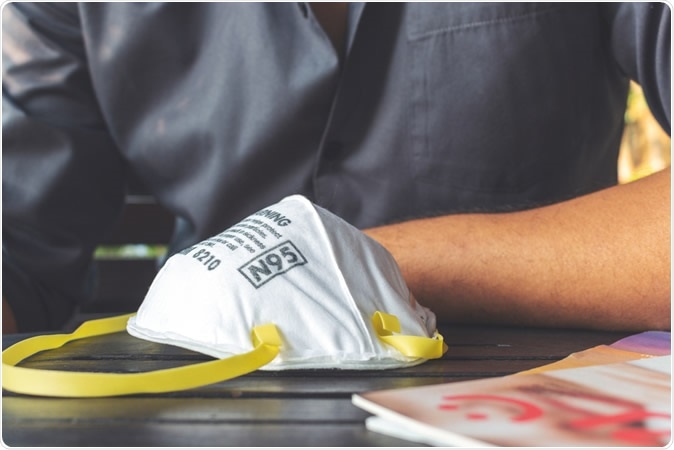Amid the coronavirus global pandemic, the world is facing a shortage of medical supplies, especially those intended to protect health workers. With the high demand for personal protective equipment (PPE), including surgical masks and N95 masks, many people are left with no choice but to try and decontaminate this equipment for extended use. Now, a new study by experts shows how N95 masks can be adequately decontaminated for further use.

Study: Effect of various decontamination procedures on disposable N95 mask integrity and SARS-CoV-2 infectivity. Image Credit: Memory Stockphoto / Shutterstock
The researchers at the National Institutes of Health Rocky Mountain Laboratories (RML), part of the National Institute of Allergy and Infectious Diseases (NIAID), in collaboration with the University of California, Los Angeles, have demonstrated ways to decontaminate and disinfect N95 masks, which can help healthcare workers to protect themselves even if there is a shortage of supply.
The group tested four methods to decontaminate the mask to determine which one is the most effective and their effects on the integrity of masks. They tested the decontamination of small sections of the N95 filter fabric that has been exposed to severe acute respiratory syndrome coronavirus 2 (SARS-CoV-2), the virus that causes COVID-19 or coronavirus disease. The decontamination methods included ultraviolet light, 70 percent ethanol spray, vaporized hydrogen peroxide (VHP), and 70-degree Celsius dry heat.
Which are effective?
The basis of the study, which was posted on MedRxiv, a publication for scientists whose study has not yet been through peer review, is through years of studies about decontamination.
The four decontamination procedures, all can eradicate the virus, but one method degraded the mask material – the ethyl alcohol.
“We found that any ethanol exposure significantly altered mask integrity, as previously reported. We also found that the impact of 70% ethanol on mask integrity appears time-dependent. In fact, thirty minutes after 70% ethanol application, there was even a larger decline in function, even though the N95 masks feel dry to the touch. Consistent with prior studies, we did observe a decline in SARS-CoV-2 infectivity (as assessed by Vero E6 culture) after certain decontamination strategies,” the team wrote in the paper.
First, the researchers tested samples of N95 material applied to the live virus in a biosecure laboratory. The team tested the methods on the mask material and the repeated them on whole masks without the virus to see if the structure and functioning will remain intact even after rounds of decontamination.
After the tests, the team found that ethanol spray damaged the integrity of the mask, particularly the respirator’s fit and seal, after two rounds of decontamination. The team recommends not using ethanol spray for decontamination on N95 respirators. On the other hand, the team found that ultraviolet light and heat-treated respirators also showed a degree of problems after three rounds of decontamination, suggesting that masks disinfected using these methods should be reused only twice.
The masks treated under VHP had no failures, showing that the mask can be reused three times. The researchers suggest using VHP as the method for decontamination since it is the most effective. Further, the team found that SARS-CoV-2 could no longer be detected after only a 10-minute treatment.
The ultraviolet light and dry heat treatments can be used as long as methods are applied for at least an hour, and after they can be used just twice. They also encourage anyone who decontaminates their N95 mask to check the respiratory fit and seal over the face before each reuse.
“FIT test data showed functional degradation by both ethanol and UV decontamination to different degrees. VHP treated masks showed no significant change in function after two treatments. We also report a single SARS-CoV-2 virucidal experiment using Vero E6 cell infection. We hope our data will guide further research for evidenced-based decisions for disposable N95 mask reuse and help protect caregivers from SARS-CoV-2 and other pathogens,” the team concluded.
What CDC recommends
Due to the scarcity of mask supply, particularly the N95 masks used by healthcare professionals, the U.S. Centers for Disease Control and Prevention (CDC) recommends a combination of approaches to conserve supplies while keeping health workers safe.
The CDC recommends health care institutions to minimize the number of individuals using respiratory protection through engineering and administrative controls, put in place practices for extended use or limited reuse of N95 masks, focus on the use of the masks for those who are at highest risk of contracting infection, and use alternatives to N95 respirators.
The study, however, has shown feasible ways to decontaminate these masks for reuse. These methods can help address the problem with the lack of medical supply to protect the health care workers.
Important Notice
medRxiv publishes preliminary scientific reports that are not peer-reviewed and, therefore, not be regarded as conclusive, guide clinical practice/health-related behavior, or treated as established information.
Source:
- U.S. Centers for Disease Control and Prevention (CDC). (2020). Recommended Guidance for Extended Use and Limited Reuse of N95 Filtering Facepiece Respirators in Healthcare Settings. https://www.cdc.gov/
Journal reference:
- Smith, J., Hanseler, H., Welle, J., Rattray, R, Campbell, M., Bortherton, T., et al. Effect of various decontamination procedures on disposable N95 mask integrity and SARS-CoV-2 infectivity. medRxiv. https://www.medrxiv.org/content/10.1101/2020.04.11.20062331v1